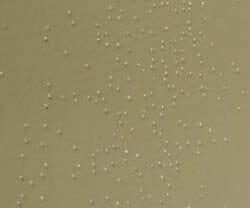
Notice in Figure 4 that paper has been used to cover the workbench and the back wall. Mixing is more critical than many think, and often not enough care is taken during the mixing and reducing process.
During drying, when either air amplifiers are used or flash time is allowed between coats. During application, when the sealer, basecoat and clearcoat are being applied and. During vehicle preparation (sanding and cleaning of the vehicle). During mixing or when preparing the paint for application. There are four times during the painting process when a painter must consider dirt contamination: This defect must be removed and the job repainted, because the coating has failed. If sprayed in this condition, the paint can look like dirt. Paint catalyzes much more slowly, and the first step is some of the paint hardening while a vast amount remains liquid. New painters may believe that once the pot life has been exceeded, paint quickly turns into a densely catalyzed glob, like what you might be see with primer when you come back after lunch and realize you haven’t cleaned the primer gun. You may not find this name in the common paint defects category however, the condition is caused by using paint that has exceeded its pot life. Painters should use tools such as a magnifying glass to look at the paint surface closely. Also, the crater is an identifying aspect of fisheye. The difference between this and dirt is that the dirt will often be in certain areas and not generally over the surface of the panel. A close look at the defect will reveal a crater where the coating has not flowed over the surface. General fisheye are craters and easily identified, but sometimes small fisheye can be mistaken for dirt or even solvent popping. Dirt is less general, confined to a specific area or appearing as random nibs. Solvent popping can be distinguished from general dirt because it typically occurs on a complete panel. The condition can be aggravated by forced drying or uneven heating of the surface. Solvent popping is blistering in the paint caused by solvents not allowed to escape from the undercoat, basecoat or clear before the next coat is applied. #Fisheye paint defect how to#
So let's look at these three and determine how to distinguish between them. Though dirt is often easily identified, sometimes solvent popping, fine fisheye or pot-life shock can be mistaken for dirt.

It could appear as dirt throughout the paint job, or in distinct areas, or random and scattered nibs. In fact, while I do my best to list as many tips as possible, surely someone reading will think, "He forgot…”ĭirt in the finish can come from dirt in the sealer, basecoat or clear. Though dirt can be introduced during the paint and dry process, those things that cause dirt to be left on the paint job or deposited on the paint are many - and some of the routine steps to prevent contamination can be very easy to forget or skip when you are in a hurry. If you were to look up paint defects from dirt, you would find that some consider it a paint preparation problem. Still, we cannot surrender to dirt we must do everything possible to keep dirt from getting in prior to painting. I know you are grumbling, and you are right - there is no such thing as a completely clean paint job (Fig 1).





 0 kommentar(er)
0 kommentar(er)
